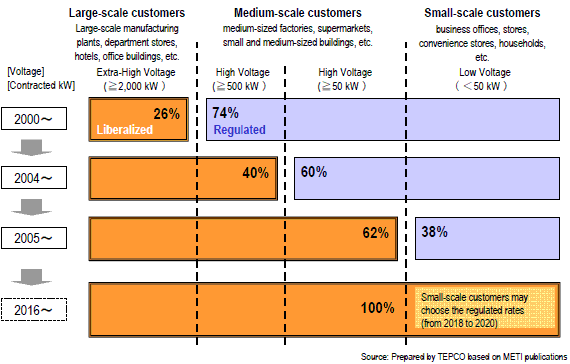Liberalization of the Electric Power Market
Restructuring of the electric power market in Japan began in the 1990s, in line with the worldwide trend toward deregulation and aimed at correcting Japan's high cost structures and high prices relative to those in other countries.

Steps Toward Regulatory Reform
The 1st Electricity Sector Reform (1995)
The revised Electric Utilities Industry Law in April 1995 opened the way for entry into the power generation market by Independent Power Producers (IPP), and made it possible for electric power companies to procure electricity from other businesses in addition to other electric utilities.
Specified Electric Utilities (businesses using their own generation, transmission and distribution facilities to supply electricity directly to customers in defined areas) also gained market access.
At the same time, the electricity rate system was revised, with the introduction of the yardstick assessment method for rate revision approval, optional contract provisions, fuel cost adjustment system, and management efficiency review.
The 2nd Electricity Sector Reform (1999)
After the Electric Utilities Industry Law was revised again in 1999, market liberalization was extended starting in March 2000 to cover extra-high-voltage (EHV) customers (20,000V or higher, with contracted power of at least 2,000 kW as a rule), mainly large factories, office buildings, department stores and the like.
This change made it possible for Power Producers and Suppliers (PPS) to supply electricity to eligible customers using the transmission networks of electric power companies. In addition, fair, equitable, and transparent rules were established for use of electric power company transmission networks by a PPS (retail wheeling service rules), and restrictions on entry into other businesses were lifted.
It also became possible to lower rates to on regulated customers simply by making notification, without the need for the approval process in effect up to that time; and conditions for setting rate plan options were relaxed.
The 3rd Electricity Sector Reform (2003)
The Electric Utilities Industry Law was revised once more in 2003. When part of the changes went into effect in April 2004, retail liberalization was expanded to high-voltage (HV) customers contracted for 500 kW or more. Then when the law was fully effected in April 2005, the retail market became liberalized for all HV customers (50 kW or above).
As a result of these reforms, approximately 60 percent of Japan's electricity market in sales volume became liberalized. At the same time, rules of conduct went into effect for ensuring fairness and transparency in the transmission and distribution sector (separate accounting, and prohibitions against information use for other than the intended purposes and of discriminatory treatment).
In addition, to encourage more active electric power exchange on a nationwide scale and bring about greater diversity in electric power procurement, the cross-area wheeling service system was revised and the Japan Electric Power Exchange (JEPX) was established.
The 4th Electricity Sector Reform (2008)
After weighing the effects of expanding liberalization of the retail market to the residential sector, it was decided to forego such expansion at this time as it might not be to the benefit of home customers. Instead, the direction of further liberalization is toward regulatory reforms that will improve the competitive environment within the scope of markets that have already been liberalized.
By way of bringing about greater competition, reforms such as revision of the wheeling rate system were introduced in this phase.
The 5th Electricity Sector Reform (2013-)
As a result of the Great East Japan Earthquake and the Fukushima Daiichi Nuclear Power Station accident in March 2011, the existing electricity sector is to be radically reviewed. In April 2013, the Cabinet decided a "Policy on Electricity System Reform", consisting of three main pillars: (1) expanded operation of wide-area electrical grids, (2) full liberalization of the retail market and power generation, and (3) legal structural separation.
Reform is to be divided into the following three phases, to be pursued with full reviews carried out at each stage and necessary measures taken.
| Phase 1 (in about 2015) |
|
|---|---|
| Phase 2 (in about 2016) |
|
| Phase 3 (in about 2018-2020) |
|
Under the Revision of the Electricity Business Act for phase 1 in November 2013 and for phase 2 in June 2014, respectively, phase 1 and 2 are to be moved toward implementation. The Organization for Cross-regional Coordination of Transmission Operators, to be newly established as one of the reforms in phase 1, will constantly monitor the state of national supply and demand and will have sweeping powers to instruct electric utilities to supply when the supply-demand balance is tight. It will also arrange a mechanism for wide-area absorption of output variation in renewable energies.
Liberalization of the retail market in phase 2 will enable all customers, including household sector to choose any electricity supplier, although electric power companies can only supply for household sector currently. In the future, bills for revision to the Electricity Business Act are to be submitted to the Diet for Phase 3 in 2015.
















